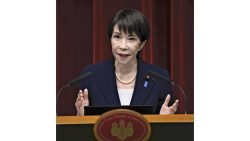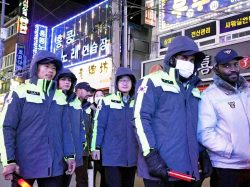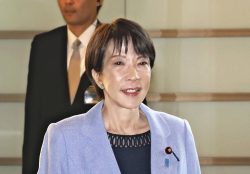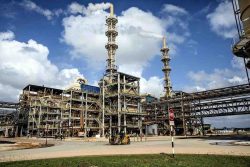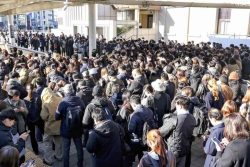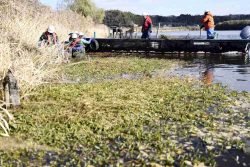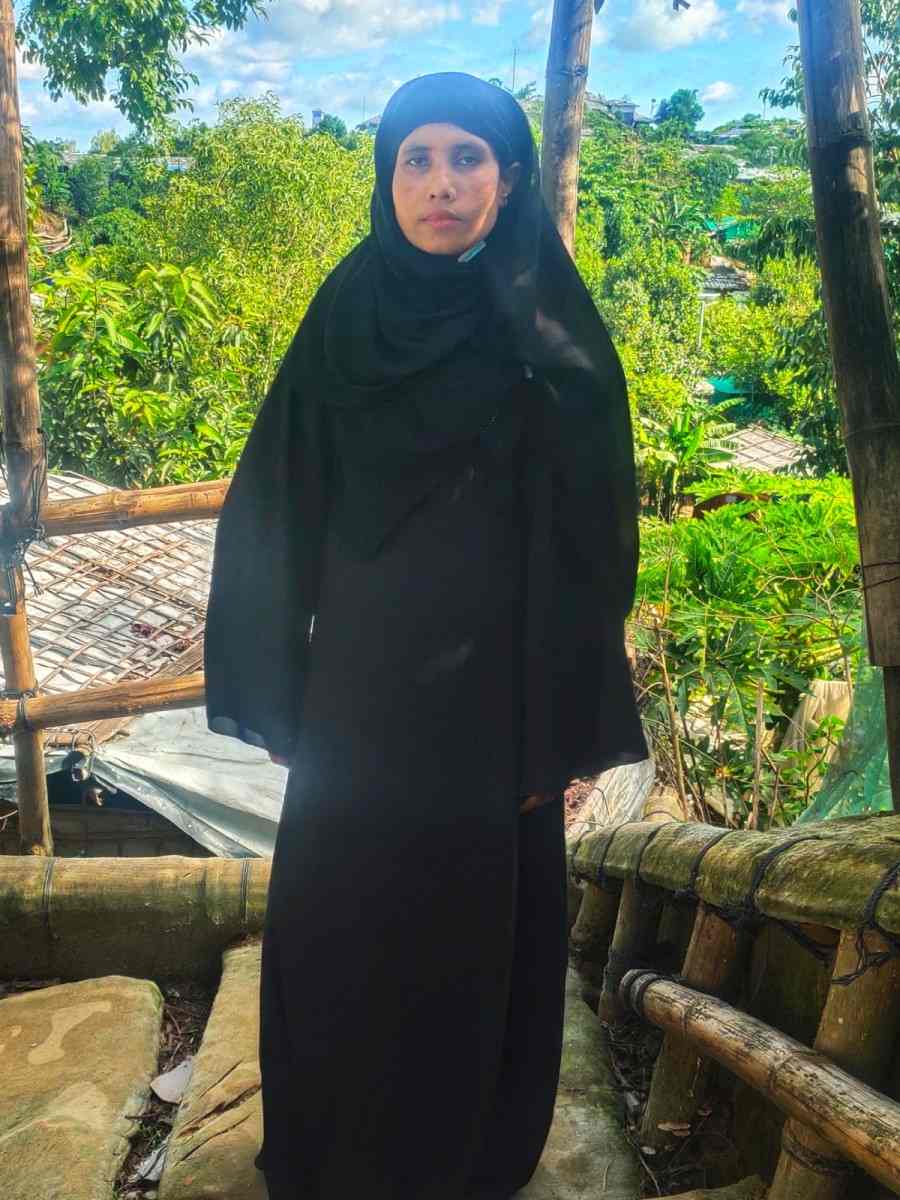
Umme Solima in her Bangladeshi refugee camp on Sunday.
13:13 JST, July 18, 2024
Every day, it’s the heat that wakes up Hamda al-Marzouq. The temperatures at her refugee camp in Jordan regularly climb to 100 degrees Fahrenheit, forcing her to wake up hours earlier than planned.
Three-thousand miles to the east, in a camp in Bangladesh, a Rohingya refugee’s makeshift home is threatened by frequent landslides from cyclones. Umme Solima’s floor has turned muddy from the rain, and she can’t afford to repair her damaged roof, made of bamboo and tarpaulin.
In South Sudan, floodwaters have submerged the small garden of Nyapuoch Phan Dak, a widow and mother of four children in her camp in Rubkona. In a place where persistent floods have forced some refugees to harvest water lilies as a source of food, Phan Dak is now searching for sustenance.
Displaced by wars, ethnic conflict and, increasingly, climate change, the number of refugees worldwide climbed to an estimated 117 million at the end of last year, according to the U.N. high commissioner for refugees. Millions of them end up in camps in nations that, according to a study last year, “are also among the countries most vulnerable to climate variability.”
Many of these refugee sites were intended to be temporary, and they sprang up on low-value land that no one else wanted. In Jordan, Bangladesh and South Sudan, the largest of these camps are vulnerable to flooding, intense storms, drought, heat waves and other bouts of extreme weather.
The Washington Post reached these three women by telephone and spoke to them with a translator. All of them want the same thing: The ability to earn a dignified living and provide a stable home for their families. They are also working to help their neighbors cope. But climate disasters mount, threatening what little normalcy they’ve managed to create in their new homes.
“These are people with huge capacity and abilities to find the solutions themselves,” said Jamie Richardson, a technical adviser in the humanitarian response department of Catholic Relief Services, which assists refugees in several countries. “We must not think of people who are vulnerable as being victims.”
Extreme heat in Jordan
Hamda al-Marzouq, 33, fled Syria in 2013 with her son after civil war broke out. Since then, she has lived at the Za’atari refugee camp, situated in Jordan eight miles from the Syrian border. Her husband died before she left.
Rows and rows of prefabricated housing units called caravans make up this camp of 78,000 people, the largest for Syrian refugees in the world. Al-Marzouq used to live in a wood-paneled caravan because it kept her cooler, but after it began attracting roaches, she moved to a metal one. Every morning, she checks her minifridge and phone to see whether they kept operating through the electricity cuts of the night. The power comes on for only an hour in the afternoon and later in the evening.
Al-Marzouq then embarks on her 15-minute walk to work. She falls behind a single-file line of others headed to their jobs in the camp, walking carefully in the strip of shade created by neighboring caravans to avoid direct sun exposure.
The Jordan summers weren’t always like this. The country just recorded its hottest June in over a century, with temperatures as high as 118 degrees Fahrenheit, and studies indicate the Middle East is warming almost twice as fast as the rest of the globe. Dry heat has turned humid, leaving damp stains on the walls of Al-Marzouq’s home. Her 10-year-old son developed asthma as dust storms grow frequent. She remembers that some refugees died during last summer’s heat wave.
“Sometimes in a heat wave, we leave our caravans and find a place with shade outdoors, because it’s cooler outside than inside,” she said. They wrap pieces of ice in washcloths to put on their heads.
Al-Marzouq is grateful to have air conditioning at her office, where she works as team leader for the camp’s recycling project. Not everyone goes to work over the summer – some prefer to stay home rather than earn money that may eventually be used on medicine for a heat-related illness. For those who do work, the hours have shifted to earlier in the day, starting at 6 a.m. instead of 9. The camp is often deserted in the morning: Many stay indoors all day, and the bustle begins after dusk, when the sun sinks below the horizon and the temperature drops.
But the biggest challenge remains the camp’s lack of funding, said Qasim Adeeb, humanitarian organization Oxfam’s Za’atari camp area manager. The number of cash-for-work jobs Oxfam offered to refugees has been cut in half in the past six years, and many refugees try to use fewer vouchers so they can save money for other products.
Oxfam is working on solutions, Adeeb said, hoping to build green spaces in the otherwise dry landscape to provide more cool areas for the refugees. They’ve also been working to increase reuse of gray water, like water drained from showers.
What al-Marzouq wants is a better job, one that’s more stable or pays more. Perhaps then she could buy a solar panel, she said, to have a power source for a fan. Air conditioning is rare in the caravans.
Landslides in Bangladesh
Cox’s Bazar, a coastal city in southeastern Bangladesh, is home to one of the world’s largest refugee camps. In 2017, hundreds of thousands of Rohingya refugees fled violent persecution in neighboring Myanmar and settled there. At its peak in 2018, the camp held 725,000 people, but that number has dropped, partly because of a 2021 fire that killed 15 and displaced roughly 55,000.
Umme Solima is one of the fortunate ones. Her home is perched atop a hill, protecting her from the worst of the tropical cyclones that regularly sweep into Bangladesh. For those on lower ground, floodwater and landslides often force them from their homes for days or weeks. Last month, at least seven Rohingya refugees died, and almost 1,200 shelters were destroyed.
All along the Bay of Bengal, where 1.4 billion people live, climate change is warming the ocean and transforming the region’s yearly monsoon from a reliable lifeline into a menace.
The extreme weather can trigger a series of catastrophes. During the summer months, the heat scorches the ground, forming cracks in the dried soil. Then the monsoon season brings flash floods. The heavy rain mixes with the soil to create mud and then deadly landslides, said Christian Aid’s climate policy adviser, Nushrat Chowdhury, displacing the Rohingya refugees.
Seven years in, what was originally a temporary camp has become somewhat permanent. Solima, 29, has lived in Cox’s Bazar for six years in a home made of bamboo and tarpaulin. Her days are spent working as a hygiene promotion volunteer in Camp 14 with BRAC, an international development organization based in Bangladesh.
But last month’s storms and landslides muddied her floor and damaged her roof. Wash facilities in the camp were damaged or broken; pathways were eroded away. The little money Solima makes is spent caring for two sons and three daughters – there’s nothing left over for repairs.
“My kids haven’t been going to school because the road to the school is damaged by the landslide,” she said. “Even though it’s a short distance, it’s too muddy to cross.”
Unlike al-Marzouq, Solima does have a solar panel. But it can’t power a fan – the small panel generates only enough electricity to turn on the lights in her home at night.
“Because of climate change, the frequency of climate events like cyclones and floods will increase,” said Mohammad Liakath Ali, head of climate at BRAC. “And if the wind speed reaches 100 to 120 kilometers per hour, [the refugees] will lose their homes.”
Like the Za’atari camp, Cox’s Bazar is short on funding and options for work. Jobs are the first line of defense for these refugees, BRAC communications officer Ayan Soofi said, providing a source of income and means to buy necessities. But as the crisis prolongs and international support dwindles, funding cuts are on the horizon.
“It’s very difficult to find livelihood in the camps,” Solima said, adding that she feels fortunate to work as a volunteer. “For me to have this opportunity, it gives me the chance to give back to my community, as well.”
Floodwaters in South Sudan
It’s been 10 years in internal displacement camps for Nyapuoch Phan Dak, 52, following the ethnic and political conflicts that have devastated South Sudan.
She and her children used to lived in Bentiu, 40 some miles from the border with Sudan. There, she had cows to provide milk and small farms nearby for fruit. But after the conflict, the family was forced to move to the camps, where the same resources no longer exist.
Floodwaters have covered much of the land for a few years now, remnants of past intense rainy seasons. Phan Dak has moved multiple times to higher ground and now lives in Rubkona camp. The cattle have been moving, too, she said, heading north toward the border with Sudan. She’s noticed because the number of cattle in her area have decreased.
“We walk long distances in the water, sometimes in the rain, and at times, we would even get no milk,” Phan Dak said. “But sometimes we’re able to get milk and sell to get something to feed our children.”
The water is so high in places that it’s better to swim than walk, she added.
While South Sudan has periodically endured drenching storms and flooding in previous decades, some scientists say climate change “supercharged” the storms that caused the latest bout of flooding.
Dikes built around the camp protect some areas from the floodwater, but the internal displacement camps have turned into “islands,” said Miyuki Yamashita, head of food systems and resilience at the World Food Program. Because they are in confined areas and the refugees have little opportunity to farm or trade, she said, they have become dependent on humanitarian assistance. And the food rations are never enough, Phan Dak said.
But the water continues to rise. Even the small high lands in the camp are beginning to submerge, and the dikes are moving, leaving even less room to grow food. The water has brought fish, though, a silver lining from the flooding.
It’s only because of well-wishers and donations that they are still alive today, Phan Dak said. There’s little room to even take a walk around the camp.
“Not only has [the water] killed our animals, but it has taken away our freedom,” she said.
If the water rises, she said, she worries that even the little food options she has now will disappear. Since additional fighting broke out in South Sudan earlier this year, her brother’s wife and kids have joined her. Both women are widows, and they have mouths to feed.
“All I wish for, all I could ever wish for,” Phan Dak said, “is for this water to disappear.”
"News Services" POPULAR ARTICLE
-

Japan’s Princess Kako Marks 31st Birthday, Contributed to Key Events This Year
-

Arctic Sees Unprecedented Heat as Climate Impacts Cascade
-

Brigitte Bardot, 1960s Sultry sex Symbol Turned Militant Animal Rights Activist Dies at 91
-

South Korea Prosecutor Seeks Death Penalty for Ex-President Yoon over Martial Law (Update)
-
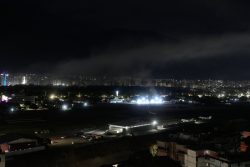
At Least 7 Explosions and Low-Flying Aircraft Are Heard in Venezuela’s Caracas
JN ACCESS RANKING
-

Japan Govt Adopts Measures to Curb Mega Solar Power Plant Projects Amid Environmental Concerns
-

Core Inflation in Tokyo Slows in December but Stays above BOJ Target
-

Major Japan Firms’ Average Winter Bonus Tops ¥1 Mil.
-

Tokyo Zoo Wolf Believed to Have Used Vegetation Growing on Wall to Climb, Escape; Animal Living Happily after Recapture
-

JAL, ANA Cancel Flights During 3-day Holiday Weekend due to Blizzard





